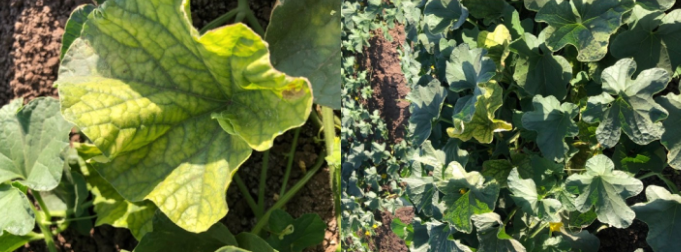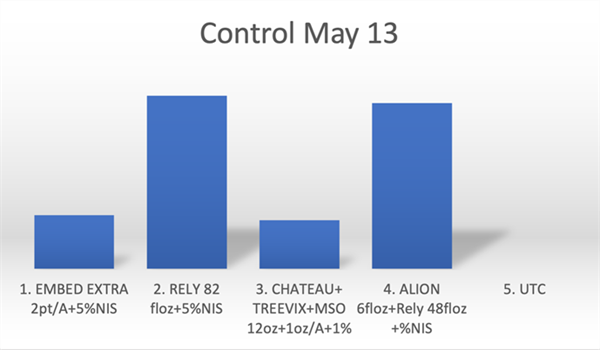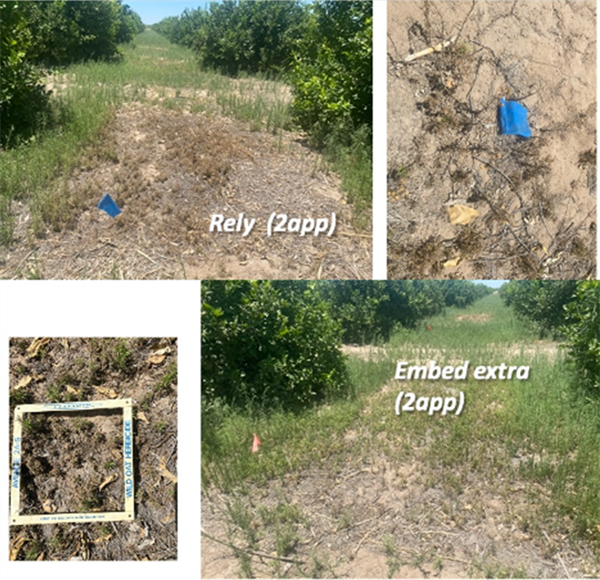Oct 16, 2019
Cucurbit Yellow Stunting Disorder Virus (CYSDV) Oct 16, 2019
Cucurbit yellow stunting disorder is a cucurbit disease caused by a plant virus named
Cucurbit yellow stunting disorder virus (CYSDV; genus
Crinivirus, family
Closteroviridae). This virus was first detected in southern California and Arizona in 2006 and infects cantaloupe and honeydew melon, watermelon, and various types of squash.CYSDV is transmitted exclusively by the whitefly,
Bemisia tabaci. Symptoms always start from the oldest leave which is a diagnostic feature of the virus.
All biotypes of
B. tabaci known to exist in North America can transmit the virus efficiently, including biotypes A, B and Q. Whitefly transmission is responsible for virus spread over short distances (e.g., within and between fields). However, with high winds whiteflies can move long distances and transport the virus. The virus can stay infectious within whiteflies for up to 9 days. As virus infection is systemic (meaning they have to be circulated inside the plant system to show symptoms) it can take 3 to 4 weeks for disease symptoms to develop following infection. This gives a window for infected symptomless plants can be unknowingly transported and can lead to epidemics. The virus is not transmitted mechanically (by touch, mechanical damage, cuts etc) or via seed. However, the virus can be efficiently transmitted even if there is low whitefly pressure in the field.
The best management approach is to monitor the whitefly population and be proactive with insecticides application. Rotate insecticides with different modes of action Group numbers to minimize development of insecticide resistance. Practice good weed management in and around fields to the extent feasible. Remove and destroy old crops/volunteers, enforce regional cucurbit -free period to eliminate the virus from the cropping system.
Diagnosis can be done at Yuma Plant Health Clinic at Yuma Ag Center or at Dr. William Wintermantel’s USDA lab in Salinas, CA (samples have to be shipped overnight). Molecular diagnosis is required as symptoms sometimes can be misleading. Dr. Wintermantel’s (
bill.wintermantel@usda.gov) team is working on looking at virus titer (amount of virus) in single and mixed infections and also looking at source of resistance. If your plants have the symptoms and like them to be tested please contact me (
bpoudel@email.arizona.edu, 928-920-1110). You will get your molecular diagnosis for free, and we will be contributing towards a research in mitigating the problem.
Sweet Shield and Novira varieties seem to do well in Yuma area.
New kid in the block! Please welcome Rebecca Ramirez! She is a recent addition to our Plant Pathology Program. Rebecca started working as a volunteer at the Plant Clinic since April, 2019 and started working full time this week. Rebecca will be working mainly on the diagnostic clinic and the Fusarium bioassay project. We are delighted to have her on board. Rebecca can be reached as
rebeccaramirez@email.arizona.edu. Send her warm welcome, stop by and say hello, send best wishes, tell her she has the best boss and all that ;)
To contact Bindu Poudel go to:
bpoudel@email.arizona.edu













